NCERT Solutions for Class 6 Maths - Playing with Numbers
| Table of contents |

|
| Exercise 3.1 |

|
| Exercise 3.2 |

|
| Exercise 3.3 |

|
| Exercise 3.4 |

|
| Exercise 3.5 |

|
| Exercise 3.6 |

|
| Exercise 3.7 |

|
Exercise 3.1
Q1. Write all the factors of the following numbers:
(a) 24
(b) 15
(c) 21
(d) 27
(e) 12
(f) 20
(g) 18
(h) 23
(i) 36
Ans:
(a) 24 = 1 × 24
24 = 2 × 12
24 = 3 × 8
24 = 4 × 6
24 = 6 × 4
∴ Factors of 24 = 1, 2, 3, 4, 6, 12, 24
(b) 15 = 1 × 15
15 = 3 × 5
15 = 5 × 3
∴ Factors of 15 = 1, 3, 5, 15
(c) 21 = 1 × 21
21 = 3 × 7
21 = 7 × 3
∴ Factors of 21 = 1, 3, 7, 21
(d) 27 = 1 × 27
27 = 3 × 9
27 = 9 × 3
∴ Factors of 27 = 1, 3, 9, 27
(e) 12 = 1 × 12
12 = 2 × 6
12 = 3 × 4
12 = 4 × 3
∴ Factors of 12 = 1, 2, 3, 4, 6, 12
(f) 20 = 1 × 20
20 = 2 × 10
20 = 4 × 5
20 = 5 × 4
∴ Factors of 20 = 1, 2, 4, 5, 10, 20
(g) 18 = 1 × 18
18 = 2 × 9
18 = 3 × 6
∴ Factors of 18 = 1, 2, 3, 6, 9, 18
(h) 23 = 1 × 23
∴ Factors of 23 = 1, 23
(i) 36 = 1 × 36
36 = 2 × 18
36 = 3 × 12
36 = 4 × 9
36 = 6 × 6
∴ Factors of 36 = 1, 2, 3, 4, 6, 9, 12, 18, 36
Q2. Write first five multiples of:
(a) 5
(b) 8
(c) 9
Ans:
(a) 5 × 1 = 5
5 × 2 = 10
5 × 3 = 15
5 × 4 = 20
5 × 5 = 25
∴ The first five multiples of 5 are 5, 10, 15, 20, and 25.
(b) 8 × 1 = 8
8 × 2 = 16
8 × 3 = 24
8 × 4 = 32
8 × 5 = 40
∴ The first five multiples of 8 are 8, 16, 24, 32, and 40.
(c) 9 × 1 = 9
9 × 2 = 18
9 × 3 = 27
9 × 4 = 36
9 × 5 = 45
∴ The first five multiples of 9 are 9, 18, 27, 36, and 45.
Q3. Match the items in column 1 with the items in column 2.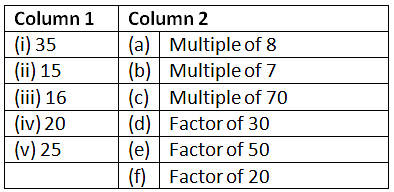
Ans:
(i) → (b)
 View Answer
View AnswerThe number 35 is a multiple of 7 because it can be divided evenly by 7.
(ii) → (d)
 View Answer
View AnswerThe number 15 is a factor of 30 because when we divide 30 by 15, we get a whole number without any remainder.
(iii) → (a)
 View Answer
View AnswerThe number 16 is a multiple of 8 because it can be divided evenly by 8.
(iv) → (f)
 View Answer
View AnswerThe number 20 is a factor of 20 because when we divide 20 by 20, we get a whole number without any remainder.
(v) → (e)
 View Answer
View AnswerThe number 25 is a factor of 50 because when we divide 50 by 25, we get a whole number without any remainder.
Q4. Find all the multiples of 9 up to 100.
Ans:
9 × 1 = 9
9 × 2 = 18
9 × 3 = 27
9 × 4 = 36
9 × 5 = 45
9 × 6 = 54
9 × 7 = 63
9 × 8 = 72
9 × 9 = 81
9 × 10 = 90
9 × 11 = 99
Multiples of 9 up to 100 are: 9, 18, 27, 36, 45, 54, 63, 72, 81, 90, 99
Exercise 3.2
Q1: What is the sum of any two
(a) Odd numbers?
(b) Even numbers?
Ans: (a) When you add two odd numbers together, the result is always an even number.
For example, 3 + 5 = 8, and 9 + 7 = 16.
(b) When you add two even numbers together, the result is always an even number.
For example, 4 + 6 = 10, and 8 + 2 = 10.
In both cases, whether you add two odd numbers or two even numbers, the sum will be an even number.
Q2. State whether the following statements are True or False:
(a) The sum of three odd numbers is even.
Ans: False
 View Answer
View AnswerThe sum of three odd numbers is always odd. For example, , which is odd.
(b) The sum of two odd numbers and one even number is even.
Ans: True
 View Answer
View AnswerAdding two odd numbers results in an even number, and adding one even number keeps the sum even. For instance, , which is even.
(c) The product of three odd numbers is odd.
Ans: True
 View Answer
View AnswerThe product of odd numbers is always odd. For example, , which is odd.
(d) If an even number is divided by 2, the quotient is always odd.
Ans: False
 View Answer
View AnswerDividing an even number by 2 may give an even quotient. For instance, , which is even.
(e) All prime numbers are odd.
Ans: False
 View Answer
View AnswerWhile most prime numbers are odd, 2 is a prime number and is even. For example, the prime numbers include 2, 3, 5, 7, 11, etc., where 2 is even.
(f) Prime numbers do not have any factors.
Ans: False
 View Answer
View AnswerPrime numbers have exactly two factors: 1 and the number itself. For example, the prime number 5 has factors 1 and 5.
(g) The sum of two prime numbers is always even.
Ans: False
 View Answer
View AnswerThis is only true if both primes are odd. For example, 2+3=5, which is odd, showing that the sum can be odd if one of the primes is 2.
(h) 2 is the only even prime number.
Ans: True
 View Answer
View Answer2 is the only even prime number because it has exactly two factors: 1 and 2. All other even numbers, like 4, 6, and 8, have more than two factors.
(i) All even numbers are composite numbers.
Ans: False
 View Answer
View Answer2 is an even number but is also a prime number. For instance, 4 is composite (factors are 1, 2, 4), but 2 is prime (factors are 1 and 2).
(j) The product of two even numbers is always even.
Ans: True
 View Answer
View AnswerMultiplying two even numbers always results in an even number. For example, , which is even.
Q3. The numbers 13 and 31 are prime numbers. Both these numbers have same digits 1 and 3. Find such pairs of prime numbers upto 100.
Ans:
- 17 and 71
- 37 and 73
- 79 and 97
Q4. Write down separately the prime and composite numbers less than 20.
Ans:
- Prime numbers which are less than 20: 2, 3, 5, 7, 11, 13, 17, 19
- Composite numbers which are less than 20: 4, 6, 8, 9, 10, 12, 14, 15, 16, 18
Q5. What is the greatest prime number between 1 and 10?
Ans: 2, 3, 5 and 7 are the prime numbers between 1 and 10. 7 is the greatest prime number among them.
Q6. Express the following as the sum of two odd primes.
(a) 44
(b) 36
(c) 24
(d) 18
Ans:
(a) 3 + 41 = 44
(b) 5 + 31 = 36
(c) 7 + 17 = 24
(d) 7 + 11 = 18
Q7. Give three pairs of prime numbers whose difference is 2.
[Remark: Two prime numbers whose difference is 2 are called twin primes].
Ans:
3 and 5
5 and 7
11 and 13
Q8. Which of the following numbers are prime?
(a) 23
(b) 51
(c) 37
(d) 26
Ans:
(a) 23
1 × 23 = 23
23 × 1 = 23
Therefore 23 has only two factors 1 and 23. Hence, it is a prime number.
(b) 51
1 × 51 = 51
3 × 17 = 51
17 × 3 = 51
51 × 1 = 51
Therefore 51 has four factors 1, 3, 17 and 51. Hence, it is not a prime number, it is a composite number.
(c) 37
1 × 37 = 37
37 × 1 = 37
Therefore 37 has two factors 1 and 37. Hence, it is a prime number.
(d) 26
1 × 26 = 26
2 × 13 = 26
13 × 2 = 26
26 × 1 = 26
Therefore 26 has four factors 1, 2, 13 and 26. Hence, it is not a prime number, it is a composite number.
Q9. Write seven consecutive composite numbers less than 100 so that there is no prime number between them.
Ans: 90 , 91 , 92 , 93 , 94 ,95 and 96 are seven consecutive composite number less than 100 and there is no prime number between them.
Q10. Express each of the following numbers as the sum of three odd primes:
(a) 21
(b) 31
(c) 53
(d) 61
Ans:
(a) 21 = 3 + 7 + 11
(b) 31 = 3 + 11 + 17
(c) 53 = 13 + 17 + 23
(d) 61 = 19 + 29 + 13
Q11. Write five pairs of prime numbers less than 20 whose sum is divisible by 5.
(Hint: 3 + 7 = 10)
Ans:
(i) 2 + 3 =5
(ii) 2 + 13 = 15
(iii) 3 + 17 = 20
(iv) 7 +13 = 20
(v) 19 + 11 = 30
Q12: Fill in the blanks:
(a) A number which has only two factors is called a _______________.
(b) A number which has more than two factors is called a _______________.
(c) 1 is neither _______ nor _______.
(d) The smallest prime number is _______________.
(e) The smallest composite number is _______________.
(f) The smallest even number is _______________.
Ans:
(a) A number which has only two factors is called a Prime number.
 View Answer
View AnswerA prime number is a number that can only be divided evenly by 1 and itself. For example, 2, 3, 5, and 7 are prime numbers.
(b) A number which has more than two factors is called a Composite number.
 View Answer
View AnswerA composite number is a number that has more than two factors. In other words, it can be divided evenly by more than just 1 and itself. For example, 4, 6, 8, and 9 are composite numbers.
(c) 1 is neither a prime number nor a composite number.
 View Answer
View Answer1 is a special number that is neither prime nor composite because it has only one factor, which is 1.
(d) The smallest prime number is 2.
 View Answer
View AnswerThe smallest prime number is 2 because it is the only even prime number. All other even numbers greater than 2 are divisible by 2 and therefore not prime.
(e) The smallest composite number is 4.
 View Answer
View AnswerThe smallest composite number is 4 because it can be divided evenly by 1, 2, and 4.
(f) The smallest even number is 2.
 View Answer
View AnswerThe smallest even number is 2 because it is the only even number that is not divisible by any other even number.
Exercise 3.3
Q1. Using divisibility tests, determine which of the following numbers are divisible by 2; by 3; by 4; by 5; by 6; by 8; by 9; by 10; by 11 (say, yes or no):

Ans:

Q2. Using divisibility tests, determine which of the following numbers are divisible by 2; by 3; by 4; by 5; by 6; by 8; by 9; by 10; by 11 (say, yes or no):
Using divisibility tests, determine which of the following numbers are divisible by 4; by 8:
(a) 572
(b) 726352
(c) 5500
(d) 6000
(e) 12159
(f) 14560
(g) 21084
(h) 31795072
(i) 1700
(j) 2150
Ans:
(a) 572
Divisible by 4 as its last two digits are divisible by 4.
Not divisible by 8 as its last three digits are not divisible by 8.
(b) 726352
Divisible by 4 as its last two digits are divisible by 4.
Divisible by 8 as its last three digits are divisible by 8.
(c) 5500
Divisible by 4 as its last two digits are divisible by 4.
Not divisible by 8 as its last three digits are not divisible by 8.
(d) 6000
Divisible by 4 as its last two digits are 0.
Divisible by 8 as its last three digits are 0.
(e) 12159
Not divisible by 4 and 8 as it is an odd number.
(f) 14560
Divisible by 4 as its last two digits are divisible by 4.
Divisible by 8 as its last three digits are divisible by 8.
(g) 21084
Divisible by 4 as its last two digits are divisible by 4.
Not divisible by 8 as its last three digits are not divisible by 8.
(h) 31795072
Divisible by 4 as its last two digits are divisible by 4.
Divisible by 8 as its last three digits are divisible by 8.
(i) 1700
Divisible by 4 as its last two digits are 0.
Not divisible by 8 as its last three digits are not divisible by 8.
(j) 5500
Not divisible by 4 as its last two digits are not divisible by 4.
Not divisible by 8 as its last three digits are not divisible by 8.
Q3. Using divisibility test, determine which of the following numbers are divisible by 6:
(a) 297144
(b) 1258
(c) 4335
(d) 61233
(e) 901352
(f) 438750
(g) 1790184
(h) 12583
(i) 639210
(j) 17852
Ans:
(a) 297144
Divisible by 2 as its units place is an even number.
Divisible by 3 as the sum of its digits (= 27) is divisible by 3.
Since the number is divisible by both 2 and 3, therefore, it is also divisible by 6.
(b) 1258
Divisible by 2 as its units place is an even number.
Not divisible by 3 as sum of its digits (= 16) is not divisible by 3.
Since the number is not divisible by both 2 and 3, therefore, it is not divisible by 6.
(c) 4335
Not divisible by 2 as its units place is not an even number.
Divisible by 3 as sum of its digits (= 15) is divisible by 3.
Since the number is not divisible by 2, therefore, it is not divisible by 6.
(d) 61233
Not divisible by 2 as its units place is not an even number.
Divisible by 3 as sum of its digits (= 15) is divisible by 3.
Since the number is not divisible by both 2 and 3, therefore, it is not divisible by 6.
(e) 901352
Divisible by 2 as its units place is an even number.
Not divisible by 3 as sum of its digits (= 20) is not divisible by 3.
Since the number is not divisible by both 2 and 3, therefore, it is not divisible by 6.
(f) 438750
Divisible by 2 as its units place is an even number.
Divisible by 3 as sum of its digits (= 27) is not divisible by 3.
Since the number is divisible by both 2 and 3, therefore, it is divisible by 6.
(g) 1790184
Divisible by 2 as its units place is an even number.
Divisible by 3 as sum of its digits (= 30) is not divisible by 3.
Since the number is divisible by both 2 and 3, therefore, it is divisible by 6.
(h) 12583
Not divisible by 2 as its units place is not an even number.
Not divisible by 3 as sum of its digits (= 19) is not divisible by 3.
Since the number is not divisible by both 2 and 3, therefore, it is not divisible by 6.
(i) 639210
Divisible by 2 as its units place is an even number.
Divisible by 3 as sum of its digits (= 21) is not divisible by 3.
Since the number is divisible by both 2 and 3, therefore, it is divisible by 6.
(j) 17852
Divisible by 2 as its units place is an even number.
Not divisible by 3 as sum of its digits (= 23) is not divisible by 3.
Since the number is not divisible by both 2 and 3, therefore, it is not divisible by 6.
Q4. Using divisibility test, determine which of the following numbers are divisible by 11:
(a) 5445
(b) 10824
(c) 7138965
(d) 70169308
(e) 10000001
(f) 901153
Ans:
(a) 5445
Sum of the digits at odd places = 4 + 5 = 9
Sum of the digits at even places = 4 + 5 = 9
Difference of both sums = 9 – 9 = 0
Since the difference is 0, therefore, the number is divisible by 11.
(b) 10824
Sum of the digits at odd places = 4 + 8 +1 = 13
Sum of the digits at even places = 2 + 0 = 2
Difference of both sums = 13 – 2 = 11
Since the difference is 11, therefore, the number is divisible by 11.
(c) 7138965
Sum of the digits at odd places = 5 + 9 + 3 + 7 = 24
Sum of the digits at even places = 6 + 8 + 1 = 15
Difference of both sums = 24 – 15 = 9
Since the difference is neither 0 nor 11, therefore, the number is not divisible by 11.
(d) 70169308
Sum of the digits at odd places = 8 + 3 + 6 + 0 = 17
Sum of the digits at even places = 0 + 9 + 1 + 7 = 17
Difference of both sums = 17 – 17 = 0
Since the difference is 0, therefore, the number is divisible by 11.
(e) 10000001
Sum of the digits at odd places = 1 + 0 + 0 + 0 = 1
Sum of the digits at even places = 0 + 0 + 0 + 1 = 1
Difference of both sums = 1 – 1 = 0
Since the difference is 0, therefore, the number is divisible by 11.
(f) 901153
Sum of the digits at odd places = 3 + 1 + 0 = 4
Sum of the digits at even places = 5 + 1 + 9 = 15
Difference of both sums = 15 – 4 = 11
Since the difference is 11, therefore, the number is divisible by 11.
Q5. Write the smallest digit and the largest digit in the blanks space of each of the following numbers so that the number formed is divisibly by 3:
(a) __________ 6724
(b) 4765 __________ 2
Ans:
(a)
The sum of the given digits = 19
The sum of its digit should be divisible by 3 to make the number divisible by 3
Since 21 is the smallest multiple of 3, which comes after 19
So, smallest number = 21 – 19 = 2
Now 2 + 3 + 3 = 8
But 2 + 3 + 3 + 3 = 11
Now, if we put 8, the sum of digits will be 27, which is divisible by 3
Therefore the number will be divisible by 3
Hence, the largest number is 8
(b)
Sum of the given digits = 24
Sum of its digits should be divisible by 3 to make the number divisible by 3
Since, 24 is already divisible by 3. Hence, the smallest number that can be replaced is 0
Now, 0 + 3 = 3
3 + 3 = 6
3 + 3 + 3 = 9
3 + 3 + 3 + 3 = 12
If we put 9, the sum of its digits becomes 33. Since 33 is divisible by 3.
Therefore the number will be divisible by 3
Hence, the largest number is 9
Q6. Write the smallest digit and the largest digit in the blanks space of each of the following numbers so that the number formed is divisibly by 11:
(a) 92 __________ 389
(b) 8 __________ 9484
Ans:
(a) We know that a number is divisible by 11 if the difference of the sum of the digits at odd places and that of even places should be either 0 or 11.
Therefore, 928389 →
Odd places = 9 + 8 + 8 = 25
Even places = 2 + 3 + 9 = 14
Difference = 25 – 14 = 11
(b) We know that a number is divisible by 11 if the difference of the sum of the digits at odd places and that of even places should be either 0 or 11.
Therefore, 869484 →
Odd places = 8 + 9 + 8 = 25
Even places = 6 + 4 + 4 = 14
Difference = 25 – 14 = 11
Exercise 3.4
Q1. Find the common factors of:
(a) 20 and 28
(b) 15 and 25
(c) 35 and 50
(d) 56 and 120
Ans: (a) Factors of 20 = 1, 2, 4, 5, 10, 20
Factors of 28 = 1, 2, 4, 7, 14, 28
Common factors = 1, 2, 4
(b) Factors of 15 = 1, 3, 5, 15
Factors of 25 = 1, 5, 25
Common factors = 1, 5
(c) Factors of 35 = 1, 5, 7, 35
Factors of 50 = 1, 2, 5, 10, 25, 50
Common factors = 1, 5
(d) Factors of 56 = 1, 2, 4, 7, 8, 14, 28, 56
Factors of 120 = 1, 2, 3, 4, 5, 6, 8, 10, 12, 15, 20, 24, 30, 60, 120
Common factors = 1, 2, 4, 8
Q2. Find the common factors of:
(a) 4, 8 and 12
(b) 5, 15 and 25
Ans: (a) Factors of 4 = 1, 2, 4
Factors of 8 = 1, 2, 4, 8
Factors of 12 = 1, 2, 3, 4, 6, 12
Common factors of 4, 8 and 12 = 1, 2, 4
(b) Factors of 5 = 1, 5
Factors of 15 = 1, 3, 5, 15
Factors of 25 = 1, 5, 25
Common factors of 5, 15 and 25 = 1, 5
Q3. Find the first three common multiples of:
(a) 6 and 8
(b) 12 and 18
Ans: (a) Multiple of 6 = 6, 12, 18, 24, 30, 36, 42, 28, 54, 60, 72, …………
Multiple of 8 = 8, 16, 24, 32, 40, 48, 56, 64, 72, …………………….
Common multiples of 6 and 8 = 24, 48, 72
(b) Multiple of 12 = 12, 24, 36, 48, 60, 72, 84, 96, 108, 120, ………
Multiple of 18 = 18, 36, 54, 72, 90, 108, ………………………………
Common multiples of 12 and 18 = 36, 72, 108
Q4. Write all the numbers less than 100 which are common multiples of 3 and 4.
Ans: Multiple of 3 = 3, 6, 9, 12, 15, 18, 21, 24, 27, 30, 33, 36, 39, 42, 45, 48, 51, 54, 57, 60, 63, 66, 69, 72, 75, 78, 81, 84, 87, 90, 93, 96, 99
Multiple of 4 = 4, 8, 12, 16, 20, 24, 28, 32, 36, 40, 44, 48, 52, 56, 60, 64, 68, 72, 76, 80, 84, 88, 92, 96, 100
Common multiples of 3 and 4 = 12, 24, 36, 48, 60, 72, 84, 96
Q5. Which of the following numbers are co-prime:
(a) 18 and 35
(b) 15 and 37
(c) 30 and 415
(d) 17 and 68
(e) 216 and 215
(f) 81 and 16
Ans: (a) Factors of 18 = 1, 2, 3, 6, 9, 18
Factors of 35 = 1, 5, 7, 35
Common factor = 1
Since, both have only one common factor, i.e., 1, therefore, they are co-prime numbers.
(b) Factors of 15 = 1, 3, 5, 15
Factors of 37 = 1, 37
Common factor = 1
Since, both have only one common factor, i.e., 1, therefore, they are co-prime numbers.
(c) Factors of 30 = 1, 2, 3, 5, 6, 15, 30
Factors of 415 = 1, 5, …….., 83, 415
Common factor = 1, 5
Since, both have more than one common factor, therefore, they are not co-prime numbers.
(d) Factors of 17 = 1, 17
Factors of 68 = 1, 2, 4, 17, 34, 86
Common factor = 1, 17
Since, both have more than one common factor, therefore, they are not co-prime numbers.
(e) Factors of 216 = 1, 2, 3, 4, 6, 8, 36, 72, 108, 216
Factors of 215 = 1, 5, 43, 215
Common factor = 1
Since, both have only one common factor, i.e., 1, therefore, they are co-prime numbers.
(f) Factors of 81 = 1, 3, 9, 27, 81
Factors of 16 = 1, 2, 4, 8, 16
Common factor = 1
Since, both have only one common factor, i.e., 1, therefore, they are co-prime numbers.
Q6. A number is divisible by both 5 and 12. By which other number will that number be always divisible?
Ans: Factor of 5 = 1,5
Factor of 12 = 1, 2, 3, 4, 6, 12
Common factor = 1
And the product of these two number is 60.
Factor of 60 = 1, 2, 3, 4, 5, 6, 10, 12, 15, 20, 30, 60.
Q7. A number is divisible by 12. By what other numbers will that number be divisible?
Ans: Since the number is divisible by 12. Hence, it also divisible by its factors i.e., 1, 2, 3, 4, 6, 12
Therefore 1, 2, 3, 4, and 6 are the numbers other than 12 by which this number is also divisible
Exercise 3.5
Q1. Here are two different factor trees for 60. Write the missing numbers.
(a) 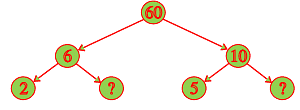
(b) 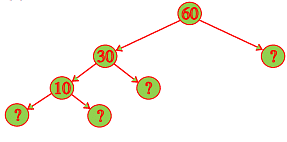
Ans:
(a) Since 6 = 2 × 3 and 10 = 5 × 2

(b) Since 60 = 30 × 2
30 = 10 × 3
10 = 5 × 2

Q2. Which factors are not included in the prime factorization of a composite number?
Ans: 1 is the factor which is not included in the prime factorization of a composite number.
Q3. Write the greatest 4-digit number and express it in terms of its prime factors.
Ans: The greatest 4-digit number = 9999 The prime factors of 9999 are 3 × 3 × 11 × 101.
The prime factors of 9999 are 3 × 3 × 11 × 101.
Q4. Write the smallest 5-digit number and express it in terms of its prime factors.
Ans: The smallest five digit number is 10000.

The prime factors of 10000 are 2 × 2 × 2 × 2 × 5 × 5 × 5 × 5.
Q5. Find all the prime factors of 1729 and arrange them in ascending order. Now state the relation, if any, between, two consecutive prime numbers.
Ans: Prime factors of 1729 are 7 × 13 × 19.

The difference of two consecutive prime factors of 1729 is 6.
Q6. The product of three consecutive numbers is always divisible by 6. Verify this statement with the help of some examples.
Ans: Among the three consecutive numbers, there must be one even number and one multiple of 3. Thus, the product must be multiple of 6.
For Example:
(i) 2 x 3 x 4 = 24
(ii) 4 x 5 x 6 = 120
Q7. The sum of two consecutive odd numbers is always divisible by 4. Verify this statement with the help of some examples.
Ans: 3 + 5 = 8 and 8 is divisible by 4.
5 + 7 = 12 and 12 is divisible by 4.
7 + 9 = 16 and 16 is divisible by 4.
9 + 11 = 20 and 20 is divisible by 4.
Q8. In which of the following expressions, prime factorization has been done:
(a) 24 = 2 x 3 x 4
(b) 56 = 7 x 2 x 2 x 2
(c) 70 = 2 x 5 x 7
(d) 54 = 2 x 3 x 9
Ans: (a) 24 = 2 × 3 × 4
Since 4 is composite. Hence, prime factorisation has not been done
(b) 56 = 7 × 2 × 2 × 2
Since all the factors are prime. Hence, prime factorisation has been done
(c) 70 = 2 × 5 × 7
Since all the factors are prime. Hence, prime factorisation has been done
(d) 54 = 2 × 3 × 9
Since 9 is composite. Hence prime factorisation has not been done
Q9. 18 is divisible by both 2 and 3. It is also divisible by 2 × 3 = 6. Similarly, a number is divisible by both 4 and 6. Can we say that the number must also be divisible by 4 × 6 = 24? If not, give an example to justify your answer.
Ans: No. Number 12 is divisible by both 6 and 4 but 12 is not divisible by 24.
Q10. I am the smallest number, having four different prime factors. Can you find me?
Ans: The smallest four prime numbers are 2, 3, 5 and 7.
Hence, the required number is 2 x 3 x 5 x 7 = 210
Exercise 3.6
Q1. Find the HCF of the following numbers:
(a) 18, 48
(b) 30, 42
(c) 18, 60
(d) 27, 63
(e) 36, 84
(f) 34, 102
(g) 70, 105, 175
(h) 91, 112, 49
(i) 18, 54, 81
(j) 12, 45, 75
Ans: (a) Factors of 18 = 2 x 3 x 3
Factors of 48 = 2 x 2 x 2 x 2 x 3
HCF (18, 48) = 2 x 3 = 6
(b) Factors of 30 = 2 x 3 x 5
Factors of 42 = 2 x 3 x 7
HCF (30, 42) = 2 x 3 = 6
(c) Factors of 18 = 2 x 3 x 3
Factors of 60 = 2 x 2 x 3 x 5
HCF (18, 60) = 2 x 3 = 6
(d) Factors of 27 = 3 x 3 x 3
Factors of 63 = 3 x 3 x 7
HCF (27, 63) = 3 x 3 = 9
(e) Factors of 36 = 2 x 2 x 3 x 3
Factors of 84 = 2 x 2 x 3 x 7
HCF (36, 84) = 2 x 2 x 3 = 12
(f) Factors of 34 = 2 x 17
Factors of 102 = 2 x 3 x 17
HCF (34, 102) = 2 x 17 = 34
(g) Factors of 70 = 2 x 5 x 7
Factors of 105 = 3 x 5 x 7
Factors of 175 = 5 x 5 x 7
HCF = 5 x 7 = 35
(h) Factors of 91 = 7 x 13
Factors of 112 = 2 x 2 x 2 x 2 x 7
Factors of 49 = 7 x 7
HCF = 1 x 7 = 7
(i) Factors of 18 = 2 x 3 x 3
Factors of 54 = 2 x 3 x 3 x 3
Factors of 81 = 3 x 3 x 3 x 3
HCF = 3 x 3 = 9
(j) Factors of 12 = 2 x 2 x 3
Factors of 45 = 3 x 3 x 5
Factors of 75 = 3 x 5 x 5
HCF = 1 x 3 = 3
Q2. What is the HCF of two consecutive:
(a) numbers?
(b) even numbers?
(c) odd numbers?
Ans: (a) The HCF of two consecutive numbers is 1
Example: The HCF of 2 and 3 is 1
(b) The HCF of two consecutive even numbers is 2
Example: The HCF of 2 and 4 is 2
(c) The HCF of two consecutive odd numbers is 1
Example: The HCF of 3 and 5 is 1
Q3. HCF of co-prime numbers 4 and 15 was found as follows by factorisation : 4 = 2 × 2 and 15 = 3 × 5 since there is no common prime factor, so HCF of 4 and 15 is 0. Is the answer correct? If not, what is the correct HCF?
Ans: No. The correct H.C.F. is 1.
Exercise 3.7
Q1. Renu purchases two bags of fertiliser of weights 75 kg and 69 kg. Find the maximum value of weight which can measure the weight of the fertiliser exact number of times.
Ans: To find the maximum weight that can measure the weight of the fertilizer bags an exact number of times, we need to find the H.C.F. (Highest Common Factor) of 75 kg and 69 kg.
- Factors of 75 =
- Factors of 69 =
The common factor is 3, so the HCF is 3.
Therefore, the required maximum weight that can measure both bags exactly is 3 kg.
Q2. Three boys step off together from the same spot. Their steps measure 63 cm, 70 cm and 77 cm respectively. What is the minimum distance each should cover so that all can cover the distance in complete steps?
Ans: Step measure by first boy = 63 cm
Step measure by second boy = 70 cm
Step measure by third boy = 77 cm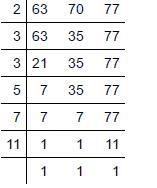
LCM = 2 × 3 × 3 × 5 × 7 × 11 = 6930
The minimum distance for each boy to cover, ensuring complete steps, is 6930 cm.
Q3. The length, breadth and height of a room are 825 cm, 675 cm and 450 cm respectively. Find the longest tape which can measure the three dimensions of the room exactly.
Ans: The measurement of longest tape = HCF of 825 cm, 675 cm and 450 cm.
Factors of 825 = 3 x 5 x 5 x 11
Factors of 675 = 3 x 5 x 5 x 3 x 3
Factors of 450 = 2 x 3 x 3 x 5 x 5
H.C.F. = 3 x 5 x 5 = 75 cm
Therefore, the longest tape is 75 cm.
Q4. Determine the smallest 3-digit number which is exactly divisible by 6, 8 and 12.
Ans: 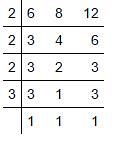
LCM of 6,8,12 = 2 × 2 × 2 × 3 × = 24
The smallest 3 digit number divisible by 6, 8, and 12 is 120
The smallest 3 digit multiple of 24 is 24× 5 = 120.
Q5. Determine the greatest 3-digit number exactly divisible by 8, 10 and 12.
Ans: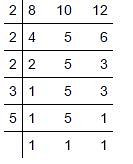
LCM = 2 × 2 × 2 × 3 × 5 = 120
Next, we need to find the greatest 3-digit multiple of 120
We may find 120 × 8 = 960 and 120 × 9 = 1080
Hence, 960 is the greatest 3-digit number exactly divisible by 8, 10 and 12
Q6. The traffic lights at three different road crossings change after every 48 seconds, 72 seconds and 108 seconds respectively. If they change simultaneously at 7 a.m., at what time will they change simultaneously again?
Ans: 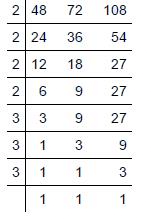
LCM = 2 × 2 × 2 × 2 × 3 × 3 × 3 = 432
Hence, lights will change together after every 432 seconds
Therefore the lights will change simultaneously at 7 minutes and 12 seconds.
Q7. Three tankers contain 403 litres, 434 litres and 465 litres of diesel respectively. Find the maximum capacity of a container that can measure the diesel of the three containers exact number of times.
Ans: The maximum capacity of container = HCF (403, 434, 465)
Factors of 403 = 13 x 31
Factors of 434 = 2 x 7 x 31
Factors of 465 = 3 x 5 x 31
HCF = 31
Therefore, 31 litres of the container is required to measure the quantity.
Q8. Find the least number which when divided by 6, 15 and 18, leave remainder 5 in each case.
Ans: LCM of 6, 15, 18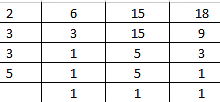
LCM = 2 × 3 × 3 × 5 = 90
Required number = 90 + 5
= 95
Hence, 95 is the required number.
Q9. Find the smallest 4-digit number which is divisible by 18, 24 and 32.
Ans: LCM of 18, 24, 32
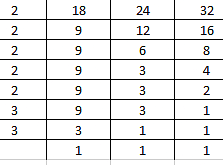
LCM = 2 × 2 × 2 × 2 × 2 × 3 × 3 = 288
Here, we need to find the smallest 4-digit multiple of 288
We find 288 × 3 = 864 and 288 × 4 = 1152
Hence, 1152 is the smallest 4-digit number which is divisible by 18, 24 and 32
Q10. Find the LCM of the following numbers:
(a) 9 and 4
(b) 12 and 5
(c) 6 and 5
(d) 15 and 4
Observe a common property in the obtained L.C.Ms. Is L.C.M. the product of two numbers in each case?
Ans: (a) LCM of 9 and 4
= 2 x 2 x 3 x 3
= 36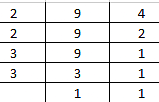
(b) LCM of 12 and 5
= 2 x 2 x 3 x 5
= 60
(c) LCM of 6 and 5
= 2 x 3 x 5
= 30
(d) LCM of 15 and 4
= 2 x 2 x 3 x 5
= 60
Yes, in each case the LCM of given numbers is the product of these numbers.
Q11. Find the LCM of the following numbers in which one number is the factor of other:
(a) 5, 20
(b) 6, 18
(c) 12, 48
(d) 9, 45
What do you observe in the result obtained?
Ans: (a) LCM of 5 and 20 = 2 x 2 x 5 = 20
(b) LCM of 6 and 18
= 2 x 3 x 3
= 18
(c) LCM of 12 and 48
= 2 x 2 x 2 x 2 x 3
= 48
(d) LCM of 9 and 45
= 3 x 3 x 5
= 45
∴ Hence, in each case the LCM of given numbers is the larger number. When a number is a factor of other number then their LCM will be the larger number.
|
94 videos|347 docs|54 tests
|
FAQs on NCERT Solutions for Class 6 Maths - Playing with Numbers
| 1. What are the basic concepts covered in the "Playing with Numbers" chapter? |  |
| 2. How can I find the factors of a number? |  |
| 3. What are prime numbers and how can I identify them? |  |
| 4. What is the importance of learning about patterns in numbers? |  |
| 5. How can I practice problems related to "Playing with Numbers"? |  |

|
Explore Courses for Class 6 exam
|

|


















